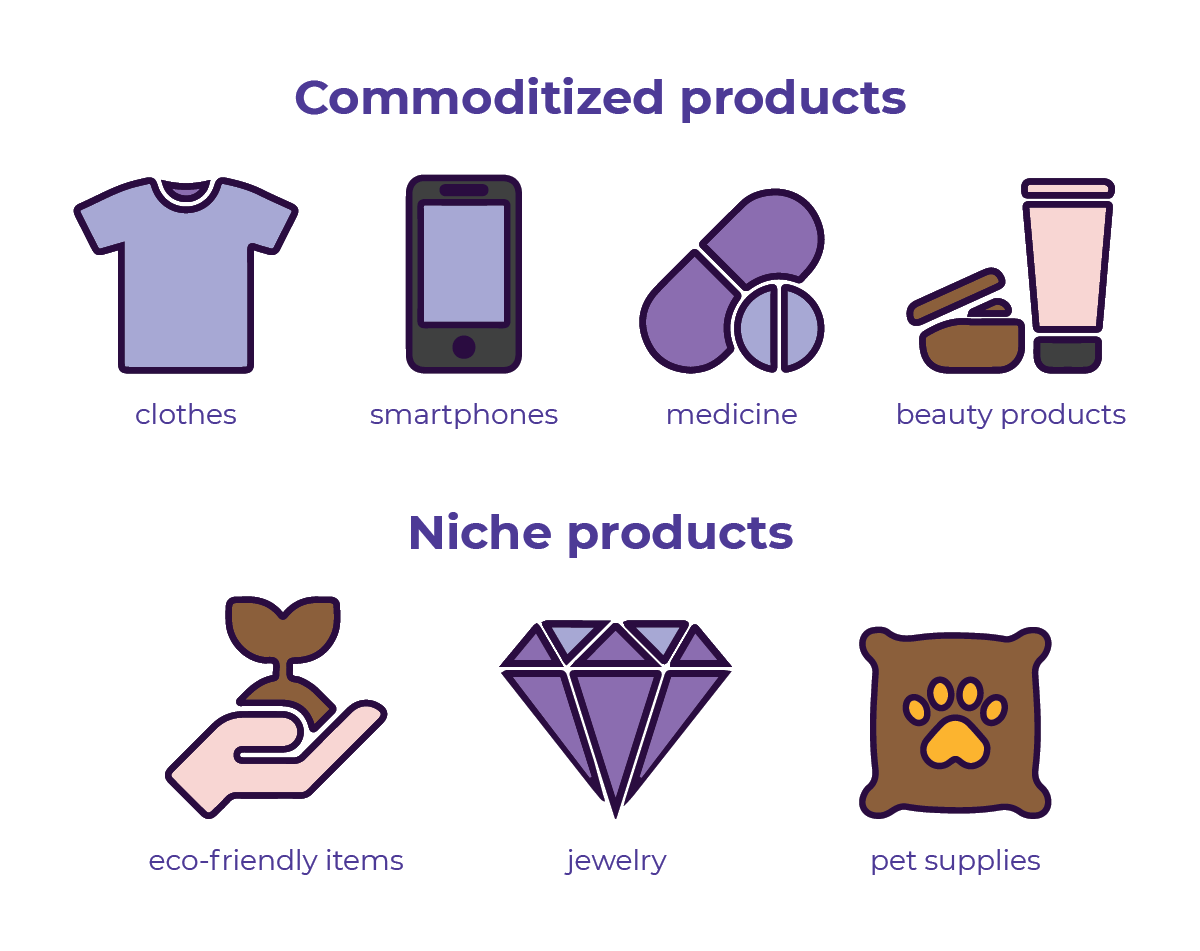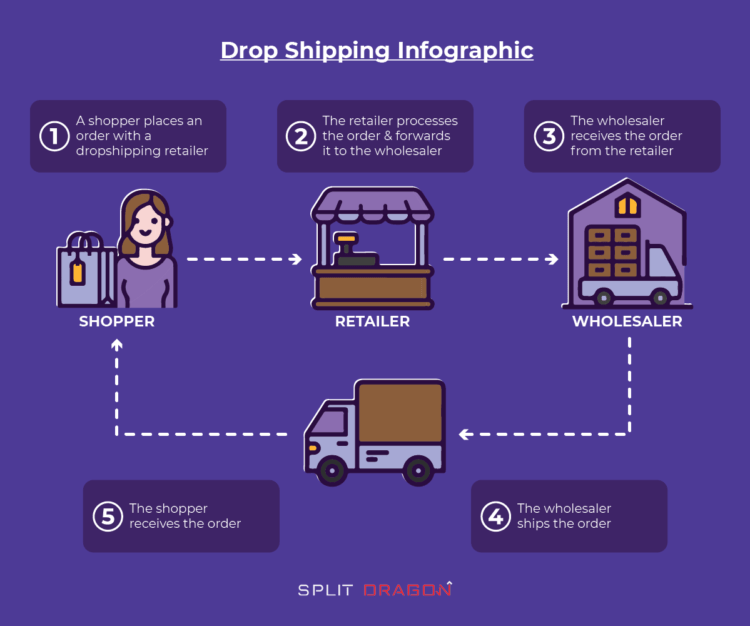It is easier to convert a sale when your product is useful and high in demand. But what if everybody is selling the same product? What will you sell next?
This is a common landscape in saturated online platforms. Competition is tough, and 95% percent of product launches fail.[*]
But don’t let this dishearten you yet.
In this article, we will talk about how to find the right products, source the value-added products, and attract more customers to your online store.
Commoditized products vs. niche products
Generally, there are two types of products you can sell online: niche products and commoditized products.

Commoditized products
Commoditized products represent the things that everybody needs and are often bought in bulk. Examples are technology, fashion, kitchen wares, office supplies, beauty products, etc. The advantage of commoditized products is that consumers are already familiar with them.
Also, there’s no need to educate the consumers about the product’s benefits and features. Moreover, it is not reliant on trends and hype since there’s already an established and consistent demand.
But the problem when selling commoditized products is the competition, plus customers’ multitude of options.
One way to counteract matter is to engage in a price war. The good thing, in e-commerce, especially in a business-to-business setting, there are other ways you can differentiate your products from others.
How to sell commoditized products
Enhance customer experience
Being present in multiple online channels is one way to enhance customer experience. Be reachable and present. Be quick in responding to queries and offer a personal touch by attaching a thank you card or by adding freebies.
Another trend that you can leverage is Augmented Reality (AR) technology. Companies like Converse, Kate Spade, and IKEA use AR. This will help propel purchase decisions by allowing the consumers to virtually try on the products.
Boost engagement with customers
For one, online buying lacks face-to-face engagement. However, this can be alleviated with live streaming, live question and answer, and by producing informative and entertaining video content.
Live Streaming is already a massive shopping industry in Southeast Asia and China. This manifested on Taobao’s 2020 annual Sing-Day global shopping festival where livestreams accounted for $6 billion in sales.
You can also make better use of social media and employ digital tools to deliver real-time engagement with customers.

Sell stories
Ben Horowitz, an investor and entrepreneur once said that “You can have a great product, but a compelling story puts the company into motion”.
Explaining why your company or brand matters will bring attention to your target consumers, but applying real success stories about the product helps build trust and motivate action.
Also, a strong story allows your prospects to see and hear the reasons why your brand is great from other consumers and not just your own.
You can start by telling stories through your product descriptions:

Niche products
Niche products are products that target a specific segment of consumers in a larger industry. Think of it as a customized or elevated product to fulfill a special demand.
Because it is advertised as exclusive and most often luxurious, niche products tend to be expensive. Niched products are defined based on:
- Level of quality – premium, handcrafted
- Demographics – income status, gender, age
- Price – discounted, luxurious
- Physiographic – interests, beliefs, values
- Location – rural, urban, city, country
An attractive thing about niche products is that you can leverage your expertise since you are specializing in something. This will set you apart from your competitors. Moreover, you don’t need to invest a lot of money in marketing. All you need is creativity.
One marketing theory that works perfectly with selling niche products is the Pareto Principle or the 80/20 rule. It states there can be 80% outcome from 20% causes or also known as “vital few”.[*]
In other words, less marketing efforts, more results.
Niche market ideas
Here are some markets you can target for your product or service:
- Health-conscious consumers –Gone are the days when consumers don’t think about the nutritional values in their food. 64% of consumers believe that food and beverage is an important factor in healthfulness.[*] Now, there’s a blanket of diet and nutrition guidelines that health-conscious people try to follow. However, access to organic food is limited. Plus, people are used to traditional recipes that are high in carbs and sugar. Whole Foods is one of the companies that understand this niche. They went beyond and built a chain of grocery stores selling only organic food to reach nutritionally aware consumers.
Product ideas you can do:
Keto ingredients (Coconut flour, almond milk, keto-friendly snacks)
Supplements
Nutrition-based recipe books
- LGBTQ+ – Pride is one of the notable social events that created an avenue for businesses to tap in. But way before the widespread acceptance, business owners, often initiated by LGBTQ+ members, are opening their businesses to cater to LGBT clientele. Now, many businesses are being more vocal in including LGBT people in their campaigns not just to bring profit but also to show real support to the community. The best example is Automic Gold that sells jewelry that is genderless and size-inclusive.
Product ideas you can do:
Non-binary clothes
Genderless fragrances
Pride gifts and accessories
- eSports – Despite being a niche, eSports are no longer a minority. As of 2020, there are 2.69 billion video game players around the world. The revenue is a whooping $159.9 billion and almost the majority of it came from the Asia Pacific market. There are a lot of add-ons that can make gaming fun. Take Discord for example. It is a gaming communications platform that offers video, voice, and text options specifically designed for the gaming community.
Product ideas you can do:
Accessories for female gamers
Game character merchandise
Personalized accessories
- Backpackers – this low-cost, independent travel option is a hit among millennials. Backpackers will spend on something that will bring comfort, ease, safety and overall add value to their experience. The best example is Matador, a travel equipment company that designs simple, straightforward yet innovative and efficient travel gears.
Product ideas you can do:
Portable and collapsible gears
Rechargeable electronics
Camera equipment
From a marketing perspective, niche products are easier to sell especially if you are passionate about them. However, there will be a tendency that your niche will fall into a commodity and become an everyday item.
So how do you source products that will actually sell?
The ultimate guide to product sourcing
Determining what product to sell can be tricky and daunting. You will invest big money so you want to make sure that your products are marketable so they won’t flop.
There are 3 ways to source products:
- DIY
- Partner with a manufacturer or wholesaler
- Dropshipping
Do-It-Yourself
DIYs or Do-It-Yourself are best for those crafty entrepreneurs. There is a wide variety of crafts you can sell, from clothes to pieces of jewelry. If you think you can create anything marketable and sellable, then DIY is for you.
Advantages of DIY
- You are already passionate about what you are selling
- You can easily adjust your product according to your client’s demands
- Easy to add or change the product line
Disadvantages of DIY
- It is hard to find the right niche market and target audience
- You need to be consistent especially in terms of quality
- Overhead expenses
- You will need to hire more people to cope with the orders
Then again, if you do not have the skill to make your handmade products, sourcing manufacturers or wholesale product suppliers and drop shipping are the best options.
Wholesale product suppliers
Once you identify what product you want to sell, you are ready to look for the right wholesaler to supply your business. Most products are sourced in China since they offer cheap labor and have a big manufacturer industry.
But regardless of the region, an ideal supplier should:
- have a price range you can afford
- reasonable minimum order quantity
- can offer samples
- easy payment option
- serves your region
- easy to work with and reliable
But where can you find these suppliers?
Specific online search
It is easier to start your search online. Moreover, there are already online wholesale marketplaces like Alibaba, Dropship Direct, Doba, and even eBay.
One thing to remember is you should be specific with your search. Else, you will just waste your time. Know the keywords of your niche for more specific search results. Also, the more potential suppliers you found, the better.
This way, you can compare quotes, requirements, and ordering process.
Attend (virtual) trade shows
While online is more convenient, going on trade shows will allow you to engage with suppliers in person. You can ask them directly if you have any questions, plus it’s more likely that your first contact with a supplier can be productive.
Canton Fair is one of the biggest trade shows in China. If you want to meet and invest in good and credible suppliers, attending trade shows like the Canton Fair is one of the best options.
Virtual trade shows are also becoming a new normal since the pandemic. Sites like VFairs allow traders to host an online trade fair so people can attend virtually.
Other important things to remember when choosing the right supplier:
- Know exactly what you need before contacting suppliers. You need to be upfront with your needs to have a smooth process.
- It is better to ask for some sample products before purchasing so that you can see them up close and test the quality.
- Do a trial engagement. Any buyer and supplier desire a long-term relationship but before deciding if it’s the right supplier, evaluate your supplier’s performance especially on the first and second transactions.
- Don’t settle for one supplier. Businesses, big or small, can go high or low. Unexpected things can happen, i.e., your supplier can run out of stock, can get sick, or close their business. That said, you should keep your supplier options open to protect your inventory and your business.
Dropshipping
If you don’t want to deal with the shipping process (packaging, distributing) or don’t want to store any products, then dropshipping is for you.
Dropshipping is an model wherein you sell items that are not physically in your hands. Instead, when you receive an order, you will just order it from your supplier and they will do the shipment on your behalf.
Here’s an infographic that could better explain dropshipping:

Smooth and easy right?
But will the customer know that the product did not come from your store? Will it be a direct competition? The answer is no. Just make sure that your supplier is open for drop shipping and blind drop shipping.
Benefits of dropshipping
Low start-up cost
Dropshipping does not need an office or storage facility, staff, and even inventory. In short, it does not require big funds. Just an online store and they are ready to sell.
Broad product range
Perfect for small businesses, dropshipping can cater to a wide range of products without the hassle of managing products on hand. It is also flexible as the store can operate anywhere and can offer various types of products.
Scalability
Since you don’t need a lot of workers to manage and a physical store to keep up, drop shipping retailers can quickly adapt to the changes in the market. In short, dropshipping is the ideal method for retailers that are experiencing fluctuating sales.
Unlimited inventory
You can tap further into the supply chain and gain access to the immense product range and virtually gain access to limitless inventory.
Challenges with dropshipping
Although there are a lot of benefits with drop shipping, there are also challenges you need to consider before jumping into this model:
Reliant to third party stock
You do not have any control of your supplier’s inventory. If they don’t have stocks, you won’t have anything to sell. Also, if the supplier did not meet the customers’ expectations or there’s any issue about the shipping and product, the retailer will be the one to resolve the issue
Hard to maintain a personal touch with customers
The ease of doing dropshipping attracts a lot of competition. One of the advantages of having your own inventory is the capacity to include personal touches like freebies or just a note.
Unfortunately, you cannot do this unless you have an agreement with the supplier.
Less profit compared to bulk buying
Bulk purchasing has a significantly lower price. However, since you are relying upon a third player, you are likely to pay more per item. This means that if you want to earn money, you will have to sell more varieties of products to cover the costs.
Difficult customer support
During the transportation of products, you cannot 100% guarantee that items will arrive in perfect conditions. If customers receive the wrong order, or damaged items, and even late product delivery, the customers will take it out on you. The problem is since you don’t oversee the inventory and order fulfillment yourself, you will have a hard time explaining.
Sourcing the right products requires research
Just like any business-to-business transaction, looking for the right product is not an overnight affair. It needs tons of research and several trial runs. Similarly, locating the right supplier will hone your negotiation skills, bring a lot of learning experiences, and requires patience.
Nonetheless, now is the best time to join the e-commerce industry.
Not yet sure how to take your seller journey to the next level? Read on how to become a Shopee seller or Lazada seller in our blog section. We also cover some exclusive insights, strategies and tricks you can use to increase your online business.





